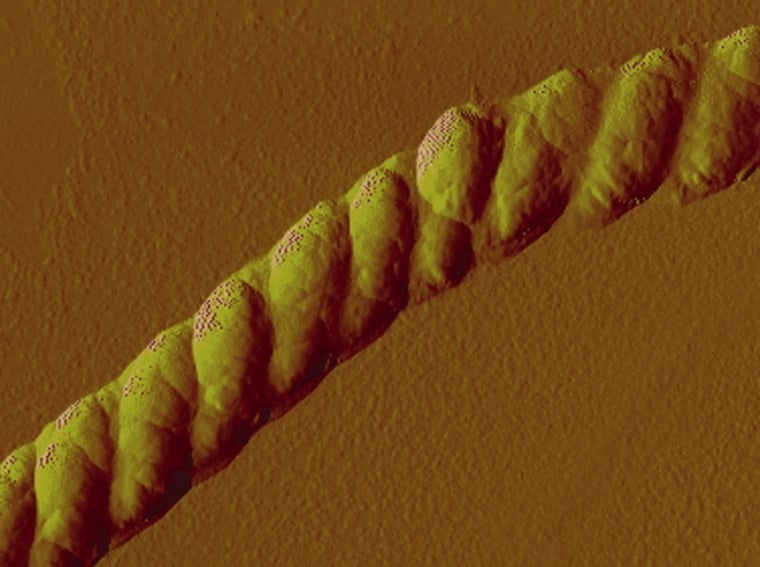Scientists have braided a rope that is less than a millionth of a meter in diameter, a major step toward self-assembling materials important for nanoscale construction and medicine.
Polymers, or long chains of molecules, were coaxed into braiding themselves into wispy nanoscale ropes that approach the structural complexity of biological materials.
The work is the latest development in the push to develop self-assembling nanoscale materials that mimic the intricacy and functionality of nature's handiwork, but which are rugged enough to withstand harsh conditions such as heat and dryness.
Although still early in the development stage, the research could lead to new applications that combine the best of both worlds.
Perhaps the ropes will be used as scaffolds to guide the construction of nanoscale wires and other structures. They also might be used to develop drug-delivery vehicles that target disease at the molecular scale, or to develop molecular sensors and sieve-like devices that separate molecules from one another.
Compelled to build
Specifically, the scientists created the conditions for synthetic polymers called polypeptoids to assemble themselves into ever more complicated structures: first into sheets, then into stacks of sheets, which in turn roll up into double helices that resemble a rope measuring only 600 nanometers in diameter (a nanometer is a billionth of a meter).
"This hierarchical self-assembly is the hallmark of biological materials such as collagen, but designing synthetic structures that do this has been a major challenge," said Ron Zuckermann, the facility director of the Biological Nanostructures Facility at the Lawrence Berkeley National Laboratory's (Berkeley Lab) Molecular Foundry.
In addition, unlike normal polymers, the scientists can control the atom-by-atom makeup of the ropy structures. They also can engineer helices of specific lengths and sequences. This "tenability" opens the door for the development of synthetic structures that mimic biological materials' ability to carry out incredible feats of precision, such as honing in on specific molecules.
"Nature uses exact length and sequence to develop highly functional structures. An antibody can recognize one form of a protein over another, and we're trying to mimic this," added Zuckermann.
Taking cues from biology
The scientists worked with chains of bio-inspired polymers called peptoids. Peptoids are structures that mimic peptides, which nature uses to form proteins, the workhorses of biology.
Instead of using peptides to build proteins, however, the scientists are striving to use peptoids to build synthetic structures that behave like proteins.
The team started with a block copolymer, which is a polymer composed of two or more monomers. Peptoid pieces were then robotically synthesized, processed and then added to a solution that fosters self-assembly.
Shapes emerge
The result was a variety of self-made shapes and structures, with the braided helices being the most intriguing. The hierarchical structure of the helix, and its ability to be manipulated atom by atom, means that it could be used as a template for mineralizing complex structures on a nanometer scale.
"These braided helices are one of the first forays into making atomically defined block copolymers," said Zuckermann. "The idea is to take something we normally think of as plastic, and enable it to adopt structures that are more complex and capable of higher function, such as molecular recognition, which is what proteins do really well.”
The research was published in a recent issue of the Journal of the American Chemical Society.
